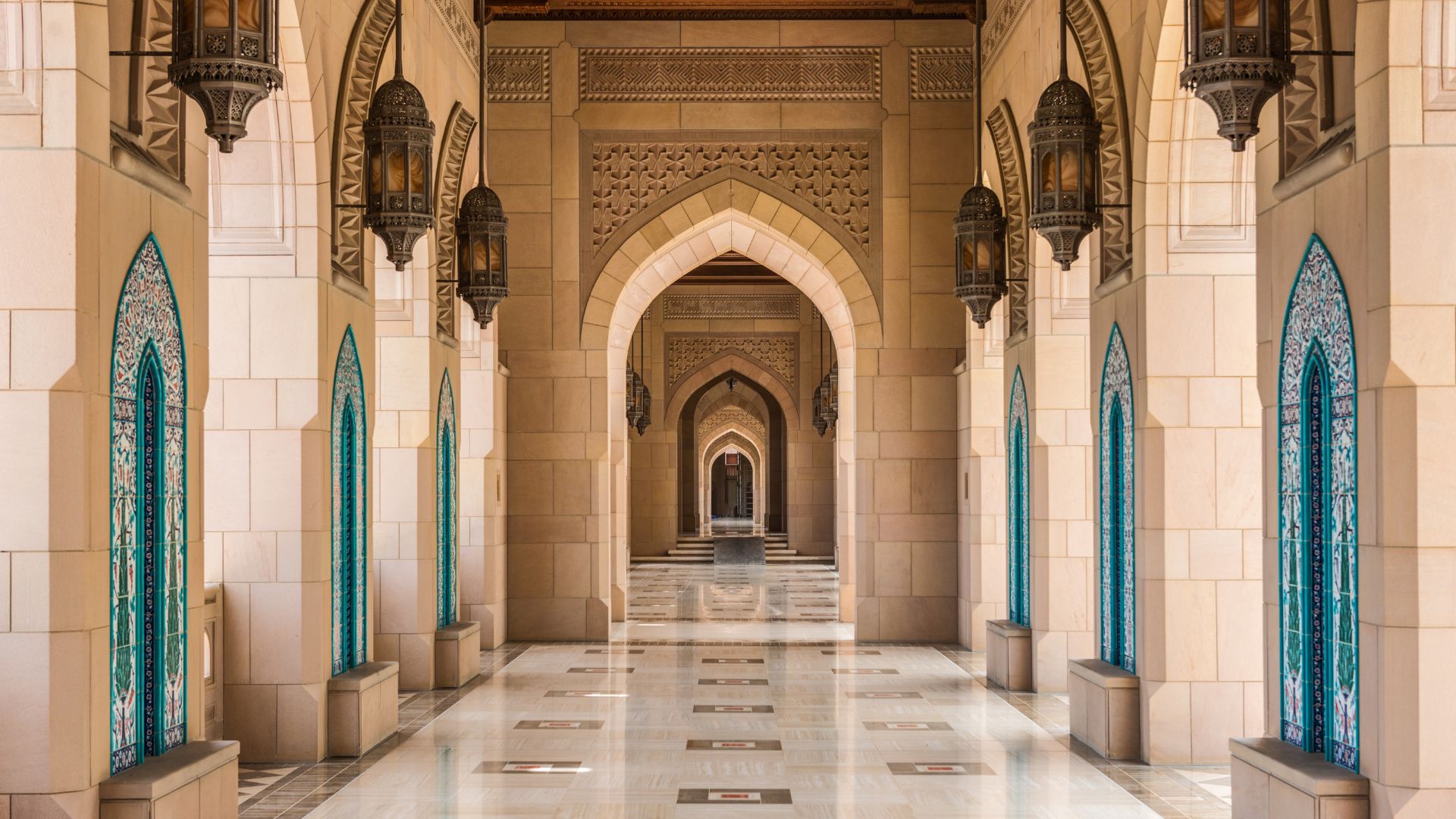
Oman
Oman is a land where ancient traditions meet dramatic landscapes—golden deserts, rugged mountains, and pristine coastline. Perfect for travellers seeking authentic Arabian experiences, Oman offers historic forts, vibrant souks, luxury desert camps, and breathtaking wadis. Whether you’re planning a tailor-made Oman tour, a cultural journey through Muscat, or an adventure into the Empty Quarter, this hidden gem combines heritage and natural beauty. Discover why Oman itineraries are ideal for explorers who value culture, nature, and understated luxury.
Top Things to Do in Oman
Where the Jinn Still Roam
Before forts rose and towns flourished, the Al Hajar mountains were believed to be home to jinn—mystical beings still respected by Omanis today. Among the most enduring legends is that of Maitha and Gaitha, two jinn sisters who built Bahla’s great wall overnight and conjured the falaj irrigation system that still sustains the village. Locals, whose families have lived here for centuries, walk in quiet reverence of these ancient protectors, believing the jinn remain alive, their presence woven into the very mountainscape.
Curious to discover the lores and legends that still shape life in these timeless mountains.
The Dhows of Destiny
Before modern ships graced the Gulf, Muscat’s fortunes sailed on the sturdy wooden dhows that still dot its harbours today. Legend says the first dhow was crafted from sacred teak gifted by the sea itself, a vessel destined to bridge faraway lands. Guided by the stars and whispered sea songs, Omani sailors carved trade routes to East Africa, India, and beyond. These dhows, more than vessels, became lifelines—symbols of resilience, craftsmanship, and Oman’s seafaring soul passed down through generations.
What ancient journeys and sea-born stories might these timeless sails still remember?
Living the Legend of Arabian Nights
Long before maps and compasses, the vast Arabian skies were the only guide. According to tales from One Thousand and One Nights, the stars were not just distant fires—they were storytellers, whispering secrets to those who could listen. Beneath these velvet skies, merchants, wanderers, and sailors charted their journeys, guided by constellations and the wisdom of generations. Even today, Omani storytellers speak of hidden meanings in the night sky—legends of love, betrayal, and destiny forever etched among the stars.
When you gaze upward, what stories might the desert sky choose to share with you?
Descent into the Abyss
Hidden beneath the stoic Al Hajar mountains lies one of the world’s largest cave chambers. Long before thrill-seekers rappelled into its vast hollow, this immense underground hall was known as the “Meeting Place of the Jinn.” Locals believed the cave was sacred—a secret gathering ground for jinn, mystical beings of smokeless fire. Its yawning entrances, high atop the Salma Plateau, were rarely approached; even today, stories linger of voices echoing from within, said to be the murmurs of jinn still convening in the deep. For those who dare to descend, it’s more than just an adrenaline rush—it’s a journey into ancient belief, where adventure and folklore intertwine.
Will you brave the descent where legends still whisper?
A Date with Dates
In Oman, the date palm is more than a tree—it’s a symbol of life, hospitality, and legacy. For centuries, dates have shaped the rhythm of Omani villages, their sweet fruit sustaining caravans, uniting neighbours, and gracing every guest’s welcome tray. Locals believe date palms are gifts from the heavens, their deep roots anchoring stories of resilience in the arid earth. It’s said that a household’s fortune is measured by the health of its date palms, each harvest a quiet celebration of abundance in the desert.
Care to taste the story that sweetens every Omani welcome?
Into the Blue with Whale Sharks
Each summer, the warm Omani waters welcome rare and regal visitors—whale sharks, the ocean’s gentle giants. Setting off at dawn from Marina Bandar Al Rowdha, you’ll slip into the open sea, where time slows and silence reigns. Beside you, these speckled giants glide, immense yet impossibly graceful. Oman keeps this secret well—few know of it, and fewer still have shared the water with them. It’s not just a swim—it’s a quiet communion with the extraordinary.
Curious to meet the ocean’s most majestic drifters in their natural rhythm?
Oman’s Ancient Trade Route
Oman’s Ancient Trade Route
Before roads cut across Oman’s mountains, trails of sweet smoke charted the way. Along the Frankincense Trail, Boswellia trees wept sacred resin, their scent rising to temples, markets, and ships bound for distant shores. Legend tells of caravans led by guardians of the trees, protecting the harvest that would shape Oman’s soul. These ancient paths still wind through misty groves, where the air holds stories of trade, faith, and the fragrance that made Oman’s name known across empires.
What sacred scents and silent footsteps might these timeless trails still recall?
Oman Travel by Season
In Oman, the rhythm of the year is shaped by its desert winds, coastal breezes, and mountain mists. Each season brings a different kind of magic—whether it’s the cool clarity of winter, the dry warmth of summer, or the mist-laced charm of the southern monsoon.

Al-Shita’ / Cool Season
November to February
Ideal for desert glamping, mountain hikes, and exploring ancient forts and villages.
Recommended Destinations:
Muscat, Wahiba Sands, Jebel Shams & Nizwa

Khareef / Monsoon Season
July to September
This is the season for lush escapes and cooler weather to discover Misty hills, green pastures, and waterfalls.
Recommended Destinations:
Salalah, Dhofar Mountains, and Wadi Darbat

Al-Sayf / Summer Season
March to June
Great time for diving, wild swimming in wadis, perfect for date farm visits and enjoying cultural experiences.
Recommended Destinations:
Jebel Akhdar, Al Hamra, and Daymaniyat Islands
Oman Travel: FAQs
What is the best time to visit Oman for travellers?
The best time to visit Oman is between October and April when the weather is pleasant for outdoor activities, desert safaris, and exploring the coastline. This period is ideal for creating a balanced Oman itinerary that includes both cultural exploration and adventure. Summers (May–September) can be extremely hot, especially in the desert, though mountain regions like Jebel Akhdar remain cooler.
How many days are enough for Oman?
Most travellers find 7 to 9 days enough for Oman. A week gives time to explore Muscat, Wahiba Sands, Nizwa, and the coastal towns. With 9–10 days, you can also include Salalah in the south or more time in the Hajar Mountains. Shorter trips of 4 to 5 days usually focus on Muscat and nearby attractions.
What kind of traveller is Oman ideal for?
Oman is ideal for travellers who want a blend of culture, adventure, and natural beauty. Adventure seekers will love trekking its rugged mountains, camping under desert skies, or diving in crystal-clear waters. Cultural explorers can immerse themselves in historic forts, bustling souqs, and traditional villages that showcase the country’s rich heritage. For those seeking comfort, Oman offers world-class resorts and curated luxury itineraries, while families and couples will find it a safe, scenic, and refreshingly uncrowded destination. This diversity makes Oman one of the most rewarding places to explore in the Middle East.
What is Oman famous for?
Oman is famous for its dramatic deserts, rugged mountains, and pristine beaches. Travellers come for cultural highlights like the forts of Nizwa, traditional souqs, and UNESCO-listed sites. Oman is also known for frankincense, adventurous wadis, and warm Omani hospitality that leaves a lasting impression.
Is Oman part of the Middle East or Asia?
Oman is located on the southeastern coast of the Arabian Peninsula, in the Middle East. It is geographically part of Asia, bordering the UAE, Saudi Arabia, and Yemen. For travellers, Oman blends Arabian traditions with coastal charm, making it a unique Middle Eastern destination.
What are the visa requirements for Oman?
Most travelers to Oman require a visa, which can be conveniently applied for online through the official Royal Oman Police eVisa portal. Passports must be valid for at least six months from the date of entry, and travelers should have proof of accommodation, a return ticket, and sufficient funds for their stay. Requirements vary by nationality: Indian citizens can obtain a 10-day single-entry eVisa, U.S. citizens can get a visa online or on arrival, and UK citizens may enter visa-free for up to 14 days. GCC nationals do not require a visa. Travelers should note that visa validity begins from issuance, not entry, and dual nationals should check regulations carefully. For the latest information and application, visit Oman visa information.
What currency is used in Oman, and can travellers use credit cards?
The currency in Oman is the Omani Rial (OMR). Major hotels, restaurants, and shopping centres accept credit cards, while local markets and small towns prefer cash. ATMs are widely available across cities and tourist areas, so travellers can withdraw local currency with ease.
What language is spoken in Oman?
Arabic is the official language of Oman, but English is widely understood, especially in cities, tourist areas, and hotels. Hindi, Urdu, and Swahili are also spoken due to Oman’s diverse expat communities, making communication easier for Indian travellers.
What local etiquette should travellers follow in Oman?
Oman is a traditional and conservative country, so modest clothing is expected, especially in mosques and rural areas. Greetings are important, and a simple “As-salamu alaykum” goes a long way. Always ask before photographing locals. Public displays of affection are discouraged, and during Ramadan, eating or drinking in public during the day is not allowed. Respectful behaviour ensures a smooth and memorable Oman trip.
What should travellers know about Omani food and dietary options?
Omani cuisine is a blend of Arabic, Indian, and East African influences. Must-try dishes include shuwa (slow-cooked lamb), majboos (spiced rice with meat), and halwa. Seafood is abundant along the coast. Vegetarian travellers will find options like lentil soups, rice, and fresh salads, though meat-based dishes dominate most menus. Food is an integral part of Oman’s travel experiences.
Is Oman budget-friendly, and how much should travellers budget per day?
Oman is moderately priced compared to other Middle Eastern countries. Travellers can expect to spend INR 6,000–10,000 per day for mid-range comfort covering meals, transport, and accommodation. Budget travel is possible with cheaper guesthouses, while luxury resorts are available for higher-end stays.
What are the main airports in Oman for international travellers?
The primary international airport is Muscat International Airport (MCT), which connects Oman to major global cities. Salalah Airport (SLL) is the second busiest, serving the Dhofar region and Khareef tourism. Sohar and Duqm airports also operate regional and domestic flights, useful for travellers planning diverse Oman itineraries.
How easy is it to travel around Oman?
Oman is often considered a self-drive destination, giving travellers the freedom to explore at their own pace. Roads are generally in good condition, but distances can be long, and GPS may not always be reliable in remote areas. Public transport is limited, so renting a car or booking guided tours is recommended. For those who prefer a planned route, AEJ offers a carefully designed self-drive Oman itinerary that covers the highlights while ensuring a smooth travel experience.
Is it safe and legal for foreigners to drive or rent cars in Oman?
Yes, foreigners can legally rent and drive cars in Oman with a valid international driving permit and their home country license. Driving is safe on highways and in cities, though desert and mountain routes require extra caution. A 4×4 is recommended for off-road adventures.
What is the connectivity like between major cities in Oman?
Oman has good road connectivity between Muscat, Nizwa, Sur, and Salalah. Highways are well maintained, though distances to the south can be long. Domestic flights connect Muscat with Salalah and Duqm, while intercity buses also operate between major towns.
Discover our carefully curated selection of itineraries to indulge your happy feet. Embark on a journey of discovery in the most intimate setting tailored to your travel needs.
Inspired by what you see? Connect with us to design a meticulously curated journey with our travel ARTHitect — the journey of your dreams is just a conversation away.
